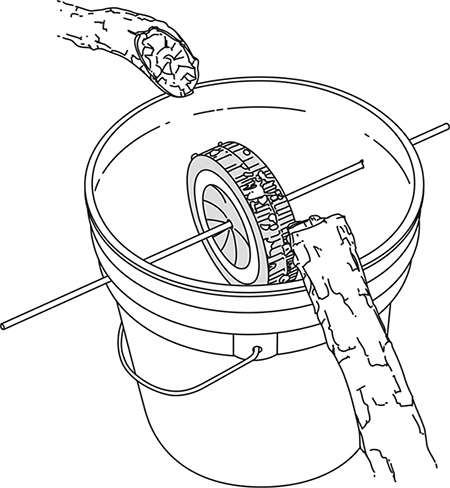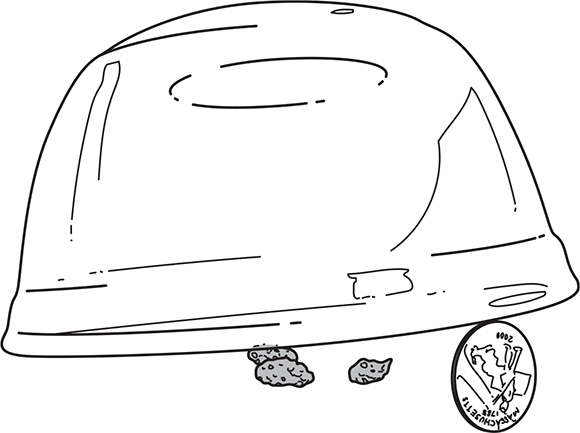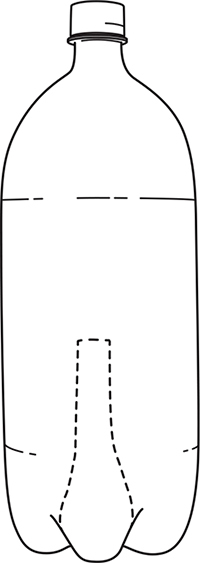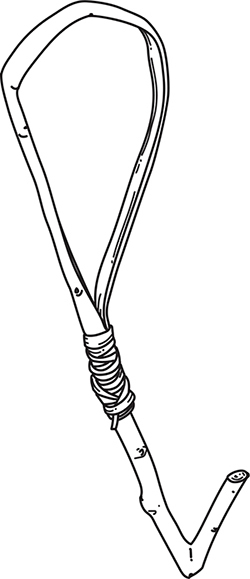
25-CENT MOUSETRAP
I’ve used mice to catch everything from fish and opossums to snakes and raccoons. Nearly everything in the forest will feed on mice when given the opportunity. One of the simplest mousetraps ever hacked involves just a quarter, a glass, and some bait such as peanut butter. Turn a wide-mouth drinking glass upside down with its front lip propped on the top of a quarter standing on its side. It may be tricky to balance at first, but this “hair trigger” is necessary. With bait placed under the glass, a mouse must scurry inside and past the quarter to take it. The slightest bump of either the quarter or the glass and the trap collapses, enclosing the mouse inside a glass cage. Peanut butter smeared on the inside of the glass will ensure a quick capture. Slide a stiff piece of paper or cardboard under the glass and mouse, and you can transport him with ease.

DEADFALL TRIGGER
A No. 2 lead pencil makes one of my all-time favorite deadfall trap triggers. I call it the break-notch trigger. Start by sawing a notch in the middle of the pencil that goes exactly halfway through it. Now, turn the pencil over and saw another notch halfway through; this second notch should be about 1" above or below the first notch on the other side. Now, with your thumb on one notch, snap the pencil into 2 pieces. It will almost always snap to create a perfectly mated trigger that makes a very sensitive deadfall trigger. The Toilet Lid Live Bird Capture hack in this chapter describes a great live capture trap using this trigger.

TOILET LID LIVE BIRD CAPTURE
Yes, a toilet lid can catch you dinner! Using bricks or wooden blocks, build an oval frame the same size as the toilet that is anywhere from 2" to 4" tall. When you place the toilet lid on top there should be no major gaps or escape routes. The bricks/blocks will provide a support for the lid. Using the Deadfall Trigger hack in this chapter with the No. 2 pencil, prop up the lid and tie 2 lines of dental floss (or thread) to the bottom half of the trigger stick and then to 2 separate pegs in the ground toward the back of the interior space. Finally, sprinkle seeds or bread inside the trap. When a bird goes into the trap for the bait it will trip the lines, which will collapse the trigger stick and cause the lid to drop, capturing the bird(s) inside.
BUILD A BIRD BOTTLE NOOSE-APULT
Here’s a cool hack based on an old bird snare. This cool little trap uses the bottom of a plastic bottle (in the original plan for the trap, it was half a coconut shell) and 2 flexible twigs to launch a noose around a bird’s neck. It’s a very inventive design that is triggered by a bird’s natural pecking behavior.
Start by cutting off the bottom 2" of a normal plastic water bottle (anything up to about 4" in diameter will work). Bury this so that it’s flush with the ground. Next bend 2 flexible twigs in an X pattern so they make a crossed arch over the opening of the bottle. (See illustration for details.) Finally, lay an open noose over the flexed twigs around the rim of the bottle and place bait (typically seeds) in the bottom of the bottle. When a bird pecks for the seeds it disturbs the bent twigs, which cast the noose upward around the bird’s neck. The bird will jump when the twigs release, and this action will cinch the noose tight.

POTS, PANS, AND UTENSIL HACKS
THE 2-LITER SPOON
Did you know a 2-liter pop bottle can yield 5 spoons? If you look closely you will see several spoon bowl shapes along the bottom. Cut out one of those extrusions along with an extended piece as a handle to extract a nearly perfect spoon for wild soups and stews or scavenged urban canned goods. The leftover top of the 2-liter bottle makes an excellent bowl with the cap on or a funnel with the cap removed. Did you know the mouth of a 2-liter bottle fits perfectly into the fuel tank of a car or truck for an emergency refueling funnel?

LOOP STICK POT HANGER
A long, flexible tree branch can be quickly converted into a pot-hanging tool. Start by cutting off a branch less than 1⁄2" in diameter just below a Y junction. Trim the shorter of the two Y branches to only 2" long. Bend the other, longer Y branch into a loop and lash it back on itself, using a whip knot. This loop can be slid over a traditional spit stick, and a pot can be hung from the 2" Y hook that dangles below. Multiple hangers can be made at different heights for a variety of cooking temperatures or pots. Note: Basswood, mulberry, maple, beech, and willow all make excellent loop stick pot hangers. In spring, you can use the bark of the basswood, mulberry, or willow as the lashing cordage.

SHOVEL IT IN
Have you ever heard the phrase “shoveling it in” referring to someone who is eating ravenously? This hack gives a new meaning to that expression. In the absence of a good skillet or griddle to use for survival cooking, several farm tools will work quite nicely as substitutes. Many believe that the term “hoecake” got the name because workers baked little corn cakes on the blades of their hoes while on break from tending the fields. A metal shovel makes a fantastic cooking griddle for meats, vegetables, and breads. The long handle is also very convenient for maneuvering a meal in and around the fire. I’ve cooked many a meal in the bush on my foldable pack shovel. A rake and pitchfork also make excellent skewers for roasting meats.
A NEW “RIND” OF COOKING
If you’re lucky enough to find a pumpkin, squash, or edible gourd in a survival scenario, don’t slice it up to eat too fast. You can simmer a fine woodsman stew inside the hollowed cavity. Meats, root vegetables, greens, and of course the flesh inside the container itself can all be boiled and stewed inside the caldron rind. After you’ve eaten this fine stew and inner flesh, use the rind several more times to boil and purify water or to make additional wild stews. Note: Pumpkin seeds can be roasted on a hot rock and make a nutritious trail snack for a survivor on the move.
NATURAL ALTERNATIVE TO ALUMINUM FOIL
One of my favorite childhood meals was what my mom called a Hobo Dinner. It was hamburger, potatoes, carrots, and onions wrapped in aluminum foil and baked in the coals of a fire. Tin foil is a perfect medium for baking meats and root vegetables in a hot coal bed. This type of cooking also lends itself very well to a survival scenario because you can do other chores while the food cooks. A natural hack to replace aluminum foil is leaves. They have to be green and nonpoisonous. My favorites are basswood, burdock, cattail, and maple. Wrap your food in 3–4 layers of leaves and tie like a birthday package with strips of green willow, mulberry, or basswood bark. Your food will bake inside exactly like in aluminum foil.
FORK HANDLE HACK
From tuna cans to Christmas cookie tins, improvised cooking pans and pots can be made from all different shapes and sizes of metals tins. However, none of them come with convenient handles. You can make a quick and sturdy handle from a regular kitchen fork. Poke 4 holes in the top rim of the tin with your knife, insert the fork tines into those holes, and bend them in an alternating pattern. This provides a safe, sturdy handle for adjusting and lifting the pot in and out of the cooking area. Placing the tin over a stump or log end allows you to poke the holes through the tin and into the wood with ease.